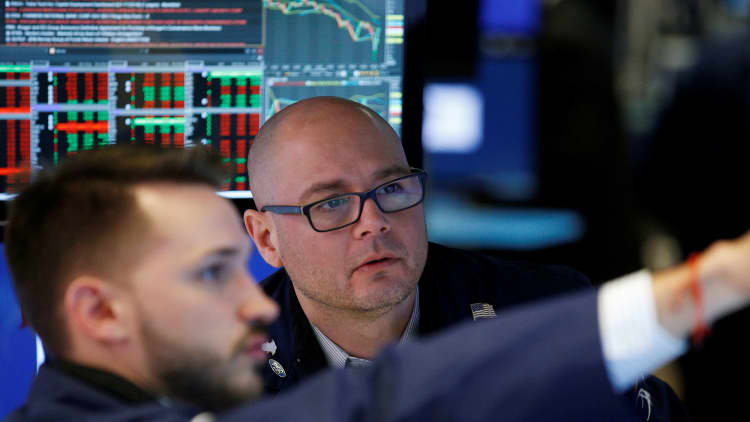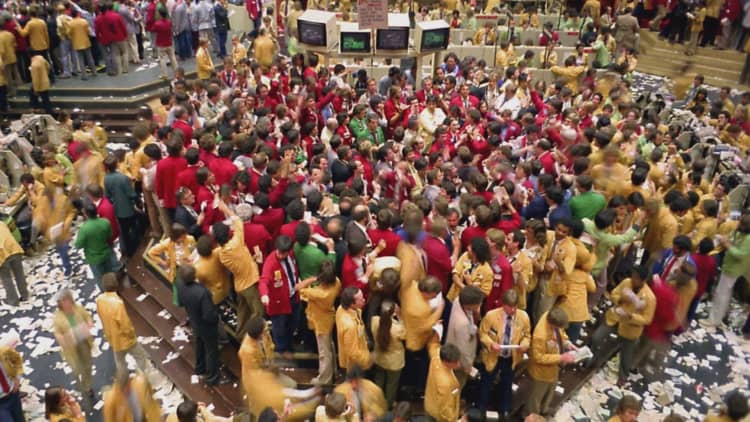
Stock futures pointed to a slightly higher open in evening trading, after a day of vicious selling took stocks into correction territory Thursday and wiped 1,000 points off the Dow.
Analysts say the stock market wash out could continue Friday morning, even though futures were trying to steady. In early Asian trading, the Nikkei was down more than 2 percent percent in early trading.
"These short-term maneuvers are very difficult to predict. I think the market will probably open lower," said Steve Massocca, managing director Wedbush Securities. "...At some point, this is going to turn and rally. We'll have to see how sustainable that rally is."
Stocks turned lower Thursday, as rising Treasury yields flirted with four-year highs. The bench mark 10-year yield was ultimately lower on the day, as investors sought safety in bonds. But the stock market sell-off worsened through the day, and the Dow ended down 1,032 points at 23,860, a decline of 4.1 percent.
Dow, S&P 500 and Nasdaq futures indicated a higher open for Friday morning in Thursday evening trading. Futures tend to be volatile overnight and often do not reflect where the market is going to open.
"The swings in the futures in the overnight market have been off the mark, both in direction and magnitude. I don't think this changes what it looks like tomorrow. You had heavy volume and massive losses at the close. I still think in the morning, it's under pressure," said Art Hogan, chief market strategist at B. Riley FBR.
Hogan expects Congress to vote in favor of the bi-partisan spending bill, despite a hold up by Sen. Rand Paul in the Senate Thursday evening. "There's enough bargaining chips for both sides to get this signed by midnight," he said.
Both the Dow and S&P 500 registered a 10 percent decline from their highs as of Thursday's close, indicating they are both in a full fledged correction, the first since the near 15 percent selloff that ended in February, 2016.
The S&P 500 broke below the key 100-day moving average 2,639 and fell through its lowest levels of the highly volatile week. The S&P fell through that low of 2,593, and closed down 100 points, to 2,581. Some strategists had expected that level to hold as a bottom for the selloff, but now they are looking toward a key technical zone at 2,538, the 200-day moving average.
"Technically having taken out the low is a bad sign. Closing below that and closing below the 100 day is a bad sign," said Hogan.
Traders will be watching developments in Washington Friday, as well as action in the market itself. If the bill fails to win approval, it could be a major negative for markets, since it also was tied to a resolution of the debt ceiling extension. But there were already negatives for the market in the bill itself.
The higher than expected $300 billion spending cap included in it rattled the bond market, and it responded by selling off. Yields move opposite price, and yields were higher after the bill details were released Wednesday and into Thursday.
Bank of America Merrill Lynch said that the spending increase will help lift the deficit to $825 billion in fiscal year 2018 and $1.1 trillion in 2019. It also increases the amount of debt the government will be issuing over the next two years.
"That's been impacting the longer end," said Michael Schumacher, director rate strategy at Wells Fargo. "It was a little bit too generous...There's a lot of people in the House saying where does this stop? You just did this big tax deal and that was a lot of debt."
The bond market has been obsessing with the fact that the U.S. government will be issuing nearly double the amount of debt it issued last year. This wave of new debt is coming, just at the same time the Fed is slowing down its purchases of Treasury securities by about $230 billion this year.
"If you include [short-term Treasury] bills, you're looking at about $1.25 trillion," said Michael Schumacher, director rate strategy at Wells Fargo, of the U.S. debt issuance. "I think people are just generally not sure where to go with all this stuff."
He noted that the Treasury market is now reacting to the stock market sell-off and the decline had subsided by late Thursday. That could keep a bid in bonds Friday. "I think the stock thing has people freaking out again. I think you watch the stock market and you watch D.C.," he said.
WATCH: Five strategies you should use to protect your portfolio



